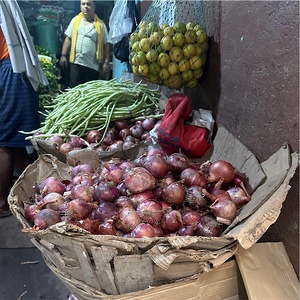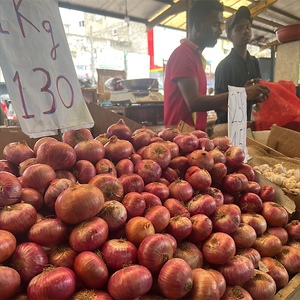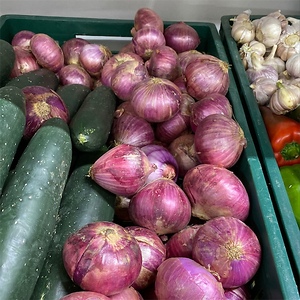


Pyaz Onions
Estimated Inventory, ea : 0
Description/Taste
"Pyaz" is the Indian term for Onions, with Red Onions being the most prevalent variety in India. Typically, these Onions are medium-sized, ranging in diameter from 7.5 to 10 centimeters. They are usually spherical or slightly flattened, featuring a thin, reddish-purple outer skin that is paper-thin. The surface of Red Onions is glossy and smooth, marked by vertical striations that run from the top to the bottom. Their papery outer skin peels away in layers, revealing a core that is more white than purple. Red Onions contain sulfurous compounds, lending them a sharp, slightly sweet, and earthy aroma that can induce tears. When raw, Red Onions have a potent flavor which softens upon cooking, enhancing their natural sweetness.
Seasons/Availability
Red Onions, known as "Pyaz" in India, are available throughout the year.
Current Facts
The botanical name for Onions is Allium cepa, classified under the genus Allium. Onions are an essential vegetable in Indian cuisine and among the oldest cultivated in the region. The leading onion-producing states in India include Maharashtra, Tamil Nadu, Bihar, Andhra Pradesh, and Nashik. Indian Onions display a broad spectrum of colors, tastes, and varieties, such as red, white, and yellow globe Onions, along with specific types like White Patna, Large Red, Patna Red, Nashik Red, Yagiri or Bellary Red, and Dhulia. India ranks as the second-largest onion producer worldwide, trailing only behind China, with an annual production of 30 million tonnes and a domestic consumption of about 15 million tonnes each year.
Nutritional Value
Onions are rich in chromium, a trace mineral that enhances a cellular response to insulin, and vitamin C, which supports the maintenance of healthy skin, blood vessels, bones, and cartilage, while also bolstering immune function. They contain flavonoids such as quercetin, which can reduce inflammation and lower blood pressure. The antioxidants in Onions may help reduce oxidative stress, strengthen antioxidant defenses, and decrease bone loss, which could potentially help in preventing osteoporosis. In traditional Indian medicine, Onions hold a significant place and are documented in ancient texts like the "Charaka Samhita," a cornerstone of Ayurveda written in the sixth century B.C. This text specifically highlights Onions for their beneficial effects on digestion, the heart, eyes, and joints.
Applications
Red Onions are fundamental in most Indian sauces, and in India, these Onions often exhibit a slightly pink hue and a milder flavor. They are frequently tossed into salads with lemon juice, black salt, and red chili powder, served alongside spicy pickle relish called achaar, and featured in recipes like Do Piazza. In North India, kebabs and curries, as well as the laden mutton and chicken 'sail' dishes of the Sindhis, are known for being rich in Onions. Vegetarian dishes, such as the Sindhi sai bhaji—a spinach and vegetable stew—and sail mani, rotis cooked in a mint sauce, also heavily incorporate Onions. A popular Indian dish called rajma showcases the technique of "bhunoing," where Onions are sautéed in oil or ghee until very dark brown. In Indian cuisine, Onions complement spices like cumin, coriander, turmeric, mustard seeds, and garam masala, and pair well with ingredients such as ginger, garlic, tomatoes, chilies, lentils, legumes, meats, fish, yogurt, and citrus. When stored in a cool, dry, and dark place with adequate air circulation, Onions can last from one to several months.
Ethnic/Cultural Info
While Onions are a staple in Indian cuisine, many Buddhists and Jains abstain from consuming Onions and other pungent vegetables like garlic. In these traditions, Onions are thought to stimulate negative emotions and energies, potentially increasing passion and ignorance, which are seen as obstacles to spiritual practices aimed at achieving purity, calmness, and elevated consciousness. The principle of ahimsa, or non-violence, which is central among Jains and some Buddhist sects, discourages the consumption of Onions as harvesting them involves killing the plant. Conversely, the deep-rooted affection for Onions among Punjabis, Sindhis, and Delhiwallahs can be significantly attributed to the influence of Mughal cuisine. The Mughals, who once ruled vast regions of the Indian subcontinent, introduced Persian culinary foods like biryani, where fried Onions, or "birista," play a crucial role both as a garnish and a flavor-enhancing layer.
Geography/History
Onions are believed to originate from Central Asia, Iran, or Pakistan, thriving in temperate climates with moderate seasonal changes. In India, while commercial cultivation in dominates due to widespread demand, Onions are also commonly grown in domestic gardens, particularly when cultivated alongside other vegetables and herbs. Over thousands of years, Onions have been cultivated and dispersed worldwide, likely reaching India through ancient trade routes that connected the country to Central Asia, the Middle East, and the Mediterranean. India now exports fresh Onions to countries such as Bangladesh, Malaysia, UAE, Sri Lanka, and Bahrain. Onions are readily available in various settings across India, including grocery stores, farmers markets known as "sabzi mandis", and street vendors selling them along roadsides.
Recipe Ideas
Recipes that include Pyaz Onions. One
| Cooking Carnival |
|
Pickled Onion (Vinegar Onion | Sirke Wale Pyaz) |
| Something's Cooking With Alpa |
|
Bharwa Pyaz ki Sabji Recipe, Stuffed onion |










